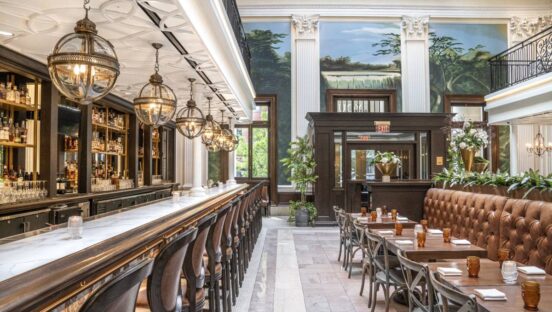Restaurateur Giorgios Bakatsias doesn’t shy away from chill January weather or sizzling August heat with his new, garden-inspired dinner spot, Rosewater Kitchen & Bar, which opened last fall in Raleigh, North Carolina.
The concept—Bakatsias’ 11th in his 30-plus years in the industry—embraces the weather, ingredients, and beauty of each of the state’s seasons, all while offering a guest experience reminiscent of Mediterranean village dining. Opening a restaurant that blends elements of two entirely different regions came naturally to Bakatsias, who originally hails from Karitsa, Greece.
To create the concept, he walked a line between North Carolina and Mediterranean influences. Despite environmental and cultural contrasts, the two regions are linked in their appreciation for the beauty of nature.
Housed in a former Bruegger’s Bagels, the retrofitted space features a Mediterranean-style solarium dining room, which creates a garden party–like atmosphere year-round. Rather than close the dining room during winter, Bakatsias invites guests to dine in the beauty of all four seasons, even in colder months when, he says, it’s best to “enjoy the coolness with the perfect sweater.”
Rosewater’s menu embraces nature, too; it’s infused with fresh, European flavors, but underpinned by seasonal North Carolina ingredients to render the perfect cocktail of global and local. For both culinary offerings and aesthetics, the secret to the sauce rests in melding seemingly disparate ideas.

Veteran restaurateur Giorgios Bakatsias
How did you create a concept that’s reminiscent of a garden party and works all year, even in winter?
We have a 50-seat kitchen and bar, as well as a grand room, then you walk into another, 60-seat room, which is the glassed-in garden dining space. We can open the sliding doors in that space, so guests are eating in the garden on a nice day, or we can keep them closed if it’s colder. We have the ability to be outside all year.
It’s great to feel all the outdoor essence of the seasons, and we have a lot of indoor plants in addition to the outside gardens. There’s that golden, Mediterranean energy year-round, but the guests have different layers throughout the year.
How does the menu complement the aesthetic you’ve cultivated?
The menu is very conducive to sharing. Sharing has been around for thousands of years—you get the chance to sample more flavors, and it also creates a certain warmth during dining.
The Rosewater menu is good for this style, but if you want to enjoy a warm seafood stew by yourself, you can do that as well. It’s well-designed for both, and it’s flexible—just like the space.
The menu is set to change four times a year or more. We have farm partners who make it possible for us to adjust with them. The meats are more consistent, the vegetables change more frequently, and then we have our other North Carolina farms that supply us throughout the year with items like local honey.
Why did you choose Raleigh for a Mediterranean village–inspired concept?
Life exists within contrasts and contradictions and moments of unique balances. In Raleigh, you have this amazing business lifestyle, this wonderful activity of people. There’s a vibrant energy, and the Rosewater building was right in the center of activity, with a huge space for a garden.
I thought a dining room where people could enjoy the outdoors would work as a way for people to escape for a moment into a beautiful garden. Of course, we’re blessed with the surrounding environment of North Carolina; we have an abundance of gardens and lots of committed farmers who support our fresh ingredients.
How do you balance inspiration from faraway places with local character?
I’m inspired by little moments during travels and by various cultures. It’s important to be inspired by different cultures around the world, but to also be grounded enough to interpret that inspiration in a way that works with where you are, with that specific moment and location in time.
I wanted to create a concept with some European romance—the space itself spoke to me and inspired this—but I was inspired in different ways, too, by what’s around me.
There’s a certain balance, spirituality, and nourishment that comes from adding relaxation and Mediterranean influences but also living off the land and working with the forces of nature. Instead of being so bold as to think that I can control nature, I’m respecting it and working with what it’s giving me locally to create Rosewater. Nature has a lot of gifts, and people are relating to that idea once again.












